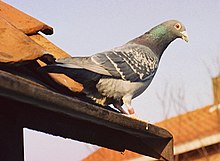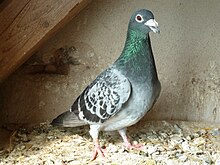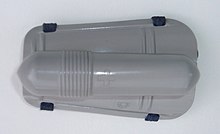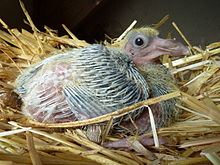Carrier pigeon
When pigeons are pigeons referred, which are now mainly kept for flight competitions and bred. The pigeon breeders generally understand their hobby as a sport, similar to horse and dog sports. Carrier pigeons used to be used to convey messages; the pigeon mail was the beginning of the air mail .
history
Messaging and homing
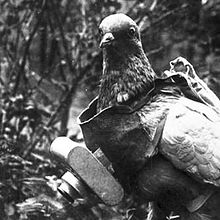
To transport an embassy, a carrier pigeon must be brought from its home loft to the place of departure, where it is held until it is used. The message is attached to a rolled up piece of paper in a container on the pigeon's foot or back. After the release , she flies back to her homeland, where the message she has brought with her can be received.
A complete explanation of the homing behavior of the carrier pigeons has not yet been found. Scientists assume that carrier pigeons as well as migratory birds can use the position of the sun and stars as well as the earth's magnetic field as a “compass” and also use visual clues. In the mid-1960s was by Wolfgang Wiltschko at robins and pigeons a magnetic sense has been detected and localized in the eye of the inclination uses, so the angle of the magnetic field lines relative to the earth's surface, direction finding. Studies published in 2000 and 2001 showed - initially in pigeons - additionally discovered accumulations of very small crystals in the skin of the upper beak, which with the help of crystallographic methods have proven to be superparamagnetic and are innervated by the trigeminal nerve . In cooperation with the experimental physicist Gerald Falkenberg from the Hamburg Synchrotron Radiation Laboratory (HASYLAB) at the German Electron Synchrotron , the "beak organ" was interpreted in the sense of a biological magnetometer in 2010 : The structures in the bird's upper beak are able to measure the locally different field strengths of the earth's magnetic field and so To help create a "geomagnetic map" while the light-dependent cells in the eye detect the orientation of the earth's magnetic field.
Before the invention of telegraphy and telephony, carrier pigeons were the only way to convey information faster than by messenger. In addition, pigeons could transport messages across enemy positions without causing a stir. To do this, however, they had to be brought from the desired destination beforehand, which was naturally difficult.
Historical examples of a long-distance use of carrier pigeons are the pigeon towers of the Republic of Genoa in the Mediterranean or the transmission of the news of the victory in the Battle of Waterloo on June 18, 1815 to the British government. Reuters began its press service with carrier pigeons. Before the First World War , the Russian and British governments tried to establish a carrier pigeon connection between Libau and Dunkirk ; Esbjerg in Denmark should serve as a stopover. This attempt failed, as did that of a line between Odessa and the French protectorate of Tunis . Carrier pigeons were used on short distances in the trench warfare of the First World War on the German and French sides when telephone and telegraph lines were destroyed and optical or wireless telegraphy was just as impossible as transmission by detectors.
In 1917 , the Swiss Army established a mail pigeon service , which was incorporated into the telecommunications troops in 1951 and was based on the Sand-Schönbühl army mail pigeon station ( Canton Bern ). The branch of service was formally abolished in the course of the army reform in 1995, but the dissolution of the Swiss Army's carrier pigeon service was not completed until 1996, after the 30,000 pigeons were handed over to the newly established Swiss carrier pigeon foundation (SBS) as a non-profit organization and the pigeons “into the civilian air released ”.
Carrier pigeon sport
organization
Today, carrier pigeons are kept and bred almost exclusively for sporting competitions. The breeders join together in pigeon breeding associations , which in turn form travel associations that hold the actual competition. The umbrella organization of the pigeon sport in Germany is the Association of German Pigeon Breeders. V. based in Essen.
The motherland of the pigeon sport is Belgium . Besides Belgium, strongholds are also the Netherlands and Germany , especially the Ruhr area . There the carrier pigeons are also called the little man's racehorses, the pigeon fancier is called the pigeon father. Valuable breeding animals can cost several thousand euros.
Competitions
During the competitions, the pigeons are transported with a special truck ( cabin express , or Kabi for short ) to a release point about 100 to 1000 kilometers from their home town , from where they start their flight home if the weather conditions permit. The decision to let go is the responsibility of a flight director certified by the Association of German Pigeon Fanciers, who collects detailed information about the weather conditions on the entire flight route. In the event of unfavorable weather conditions, especially rain, thunderstorms or fog, the release will be postponed or the flight canceled entirely. The arrival times of the individual animals in their home dovecote used to be recorded with a clock . Today this task is performed by an electronic recording system. After the race, the data for the evaluation and creation of the list of results (price list), in which 33 percent of the animals are placed, is transferred to a computer center.
The pigeon athletes describe the period between the arrival of the first and the last pigeon, or the individual placements in the price list, as bankruptcy.
The individual pigeons are identified by means of a closed number ring, which is usually raised on its right foot in the second week of life and remains there for a lifetime. The colors of the rings change every year.
Lost carrier pigeons can be reported on the Internet using this footring number. As a rule, carrier pigeons also wear a ring with the owner's telephone number.
Race flights are organized both at national and international level. The flying season for the experienced carrier pigeons of several years (old pigeons) extends from April to July and for the youngsters from August to September. During this time the old birds take part in up to 14 prize races. The youngsters complete up to five prize flights. The old pigeons cover distances of 150 to 1000 km per flight, young pigeons only up to 200 km. They reach average flight speeds of up to 100 km / h.
The pigeons are motivated to return particularly quickly if a clutch is to be incubated in the home loft or young pigeons are to be fed ( nesting method) or if the pigeons kept separately by sex find their partner on their return (widowhood method).
Efficiency
The pigeons need enormous energy reserves to complete up to 14 prize flights, some of which are up to 1400 km away. They obtain most of these from their fat reserves. Many breeders claim that every gram of fat is a burden. This may be true on short flights. However, since most travel associations have weekly price flights, whereby the distance is always increasing, the pigeons are constantly required to achieve a steadily increasing performance.
For the pigeons it becomes more difficult from prize race to prize race to renew the energy reserves they have used up.
By monitoring the energy reserves by monitoring the weight gain and loss during an entire racing season, it was found that the pigeons can gain between 25 and 50 grams in the course of a week and lose the same weight during a prize race.
So the biggest challenge is to feed the weight lost during a prize flight within a week. Only if this succeeds is the pigeon able to maintain full performance throughout the entire racing season.
Pigeons, in which the weight gain was insufficient, usually fail at the latest at the next but one prize flight. In order to reach the optimal weight again, a longer period of rest was necessary, which means that the pigeon will be out of the next three to four prize races, if not even for the rest of the racing season. For optimal weight gain in this short period of time, a high-fat diet is essential. This also consists of seeds, hemp and peanuts.
criticism
Various animal welfare organizations criticize the practice of the pigeon sport. Hundreds of thousands of pigeons would die each year in races or stranded in the cities and join the city pigeons. The breeders are only interested in performance, which is why they select weaker pigeons and kill them with full awareness by turning their necks. In addition, there is not enough free flight, no precise regulations for transport and also the use of stimulants (prohibited "doping").
Despite the use of a cabin express, a long, long transport of the racing pigeons in narrow cassettes to the release site can be problematic . The stress caused by heat and insufficient air and drinking water supply can impair performance and subsequently lead to an undesirable increase in the rate of loss - also for the owner.
Release pigeons
Some pigeon breeders also keep so-called release pigeons and tame hand pigeons , which can be booked for various occasions, such as wedding celebrations , baptisms , funerals or anniversaries. White pigeons are particularly popular because the color white is often positively associated. The dove is a symbol of peace and was abandoned during the opening ceremonies of the Olympic Games from 1920 to 1988. In television programs such as " Traumhochzeit ", pigeons were staged as part of wedding shows for a mass audience.
The breeding of pure white pigeons with a sufficiently good home finding ability is not easy. Crossbreeding often causes the pigeons to lose their ability to orient themselves, especially over long distances or in poor weather conditions. They are therefore not used as racing pigeons in competitions, but exclusively marketed as release pigeons and / or hand pigeons by suppliers of wedding pigeons .
Animal rights activists criticize the fact that wedding pigeons are exposed to considerable stress and that this promotes animal suffering. They assume that many wedding pigeons do not find their way back to their home loft due to their poor sense of direction. Every year there are numerous finds of starved and disoriented white pigeons that cannot cope with nature on their own. The behavior of some breeders who separate pairs of pigeons so that they show a stronger will to return home is particularly macabre.
The beginnings of pigeon racing in the Ruhr area
The beginnings of pigeon racing in the Ruhr area fall in the 1860s. The immigrants from the period of industrialization, who came from the agricultural eastern provinces of Prussia, kept pigeons as well as other small cattle. The so-called colonies consisted of one, one and a half or two-story houses with stables, which in some places still shape the image of the colliery settlements that are listed as historical monuments. The conception of the settlements tried to tie in with rural elements. In 1900, around 86% of the apartments had a garden and 96% a stable. From around 12% in 1893, the proportion of colliery apartments rose to 35% by 1914.
The keeping and breeding of pigeons was very popular, so that the carrier pigeon was referred to as the “miner's racehorse”. In 1869 there was already a racing pigeon sports house in Bochum. Sporting and patriotic reasons led to the founding of the first carrier pigeon travel association for the four clubs in Bochum in 1881. They facilitate the transport of the pigeons to the release sites, especially on long-distance flights, e.g. B. also organized by Königsberg / Prussia.
The carrier pigeon travel association (RV) has been based in Hattingen since 1905 . In 1891 the RV had already 24, in 1895 36, in 1897 48 and for 1899 the protocol reported that 72 clubs spread across the Ruhr area belonged to the RV. In 1894 the membership zone of the RV goes as far as Bottrop, Duisburg-Meiderich, Dortmund, Gladbeck, Moers, Mülheim (Ruhr), Neviges, Velbert, Volmarstein, vestibule near Hagen and Witten. During this time, other travel associations were founded. The three oldest associations on the Rhine and Ruhr are:
- RV of the Rheinisch-Westphalian industrial area, founded in 1881;
- RV Gelsenkirchen 1894;
- RV Essen 1898.
Even before RV Gelsenkirchen was founded, there were three carrier pigeon clubs in the area:
- Gelsenkirchen-Horst, the association 0191
- "Forward" Rotthausen, in the then still independent municipality of Rotthausen 1889
- 0208 "Heimkehr" Gelsenkirchen was founded in 1890. It is considered the first member club of RV Gelsenkirchen in 1894.
The association, to which 15 breeders belonged in 1890, was run by the German carrier pigeon association under the registration number 0208 . In 1899 the RV Gelsenkirchen was united in 1894 with a second Gelsenkirchen travel association. The association was called the travel association for Gelsenkirchen and the surrounding area, founded in 1894.
Carrier pigeon sport has been practiced in Herne since 1875, which at that time was still a modest parish in which the first mining operations began (Shamrock - Mont-Cenis). In Herne, the pigeon lovers formed the oldest local club, Heimkehr 011. The umbrella organization of German carrier pigeon lovers, the Association of German carrier pigeon lovers, was founded in 1884. In 1885 the association already had 68 member clubs in Germany.

The first pigeon club in Vest Recklinghausen was founded in 1890. The name of the association is initially war mail. The breeders of the association are initially based on the carrier pigeon travel association Gelsenkirchen und Umgebung 1894 e. Founded in 1894. V., because there was no travel association in Recklinghausen and the surrounding area. As early as the first decade of the 20th century, the Ruhr area was the center of German pigeon breeding with the greatest concentration of clubs. In 1908 the Ruhr area had the most carrier pigeon clubs in Germany. The first pigeon club in Vest Recklinghausen was founded in 1890. It later bears the name BZV Vest Recklinghausen 0467 and is the oldest carrier pigeon club in a district that in 1994 still had twelve travel associations. In 1896 the club already had 24 members with 447 pigeons.
The award of medals at the time required a flight distance of over 300 km. The information comes from old association protocols, the oldest surviving date from December 1918, and from documents in the archive of the Association of German carrier pigeon lovers. In 1897 the first carrier pigeon club was founded in the south of Recklinghausen with the name Blitz . The price flights of this time are adapted to the rail connection at the time, from Haltern , Appelhülsen , Lengerich or Lehmförde.
After an eventful history and interrupted by the two world wars, pigeon racing in the Ruhr area experienced its heyday at the beginning of the 1950s and in the following decade.
Enemies
In large parts of Europe the carrier pigeon is one of the main prey of the peregrine falcon during the race .
Even hawks can do in pigeon stocks great damage. While the peregrine falcon prefers to kill its prey in the open air, the goshawk often attacks the pigeons close to the loft and sometimes even chases them into the loft. The similarly hunting but smaller female sparrowhawk can also be dangerous for the carrier pigeons.
If a stone marten succeeds in penetrating a pigeon loft, this can have serious consequences and not infrequently lead to the death of all pigeons in the loft.
Others
- Charles-Louis Havas , pioneer and founder of the world's first news agency , had already established carrier pigeon lines between London, Brussels and Paris in the mid-1830s. With the latest news and morning prices on the London Stock Exchange, the pigeons flew from London to Paris every morning at 8 a.m., where they landed at Havas six hours later. So Havas was the first to sell the latest news and stock market prices from England to interested parties every day from 2 p.m.
- Paul Julius Reuter , founder of the Reuter news agency and former employee of Charles-Louis Havas, used carrier pigeons to transport news between Aachen and Brussels from 1850 .
- Jules Verne describes in his novel Mathias Sandorf (1885) the decoding of a message sent by carrier pigeons.
- Cher Ami († 1919) was a famous carrier pigeon of the US Army Signal Corps in France at the time of the First World War.
- GI Joe was a carrier pigeon in the US Army Signal Corps during World War II .
- The RFC 1149 regulation describes how an IP network protocol is to be implemented using carrier pigeons . Although intended as a joke, it was implemented in 2001 by a Norwegian Linux group (see also Internet Protocol over Avian Carriers ).
- In 1997 the Swiss Army dissolved the military pigeon service . Its relatives had a golden carrier pigeon on a silver-gray background as a collar tab.
- The People's Republic of China has an army of 10,000 pigeons.
See also
literature
- Werner Grundel: carrier pigeons. 4. revised and additional edition. Ulmer, Stuttgart 1993, ISBN 3-8001-7236-4 .
- Heidrun Jahn, Jürgen W. Schmidt: On the military and civil carrier pigeon system in the province of West Prussia in the years 1889–1918. In: West Prussia yearbook. Vol. 56/57 (2006/2007), pp. 55-66.
- Fiction
- Jon Day : Homing: On Pigeons, Dwellings and Why We Return . John Murray, 2019.
Web links
- The history of the carrier pigeon - information about the history of the carrier pigeon
- Map of Germany "Release places for carrier pigeons" from ZEITmagazin, September 21, 2015
Footnotes
- ↑ Klaus Schmidt-Koenig: The riddle of bird migration. Fascinating insights into the orientation of birds. Hoffmann and Campe, Hamburg 1980, ISBN 3-455-08840-6
- ↑ Wolfgang Wiltschko , Roswitha Wiltschko: Magnetic compass of European robins. In: Science . Volume 176, 1972, pp. 62-64, doi: 10.1126 / science.176.4030.62 .
- ^ Matthew N. Williams, J. Martin Wild: Trigeminally innervated iron-containing structures in the beak of homing pigeons, and other birds. In: Brain Research. Volume 889, No. 1-2, 2001, pp. 243-246, doi: 10.1016 / S0006-8993 (00) 03114-0 .
- ↑ Marianne Hanzlik, Christoph Heunemann, Elke Holtkamp-Rötzler, Michael Winklhofer, Nikolai Petersen, Gerta Fleissner: Superparamagnetic Magnetite in the Upper Beak Tissue of Homing Pigeons. In: Biometals. Volume 13, No. 4, 2000, pp. 325-331, doi: 10.1023 / A: 1009214526685 .
-
↑ Gerald Falkenberg, Gerta Fleissner et al .: Avian Magnetoreception: Elaborate Iron Mineral Containing Dendrites in the Upper Beak Seem to Be a Common Feature of Birds. In: PLoS ONE. Volume 5, No. 2, e9231, doi: 10.1371 / journal.pone.0009231 .
A magnetometer in the upper beak of all birds? On: idw-online.de from February 22, 2010. - ^ The federal authorities of the Swiss Confederation: Dissolution of the letter pigeon service completed . Press release of July 2, 1996
- ^ Association of German pigeon breeders e. V .: Found a pigeon !?
- ↑ Carrier pigeon sport - a murderous hobby. ETN e. V., accessed on July 11, 2017 . The Veterinary Association for Animal Welfare e. V. assumes loss rates due to exhaustion, weather conditions or birds of prey of up to 10% per long-distance flight, see leaflet no. 121 (as of 2009).
- ↑ § 3 no. 1b Animal Welfare Act .
- ↑ racing pigeons. Federation against abuse of animals e. V., accessed on August 10, 2014 .
- ↑ s. Point 3.3 of leaflet No. 121 of the TVT .
- ↑ White doves - cruelty to animals for the "perfect" wedding? PETA, February 2014, accessed September 28, 2017 .
- ↑ Derek Ratcliffe: The Peregrine Falcon. 2nd Edition. Poyser, London, 1993, ISBN 0-85661-060-7 , pp. 116ff.
- ↑ Terhi Rantanen: When News Was New. Wiley-Blackwell Verlag, 2009, p. 31.
- ↑ China in numbers | Statista . Website statista.com.Retrieved November 23, 2014.
